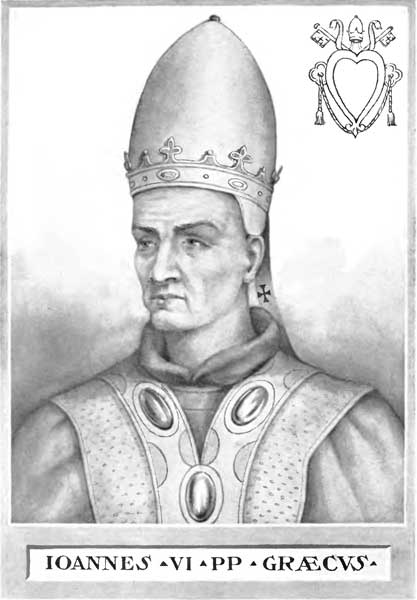.

John VI, pope from 701 to 705, son of Petronius, was a native of Greece, and succeeded to the papal chair two months after the death of Sergius I.
He assisted the exarch Theophylact, who had been sent to Italy by the emperor Justinian II, and prevented him from using violence against the Romans. Partly by persuasion and partly by means of a bribe, John succeeded in inducing Gisulf, duke of Benevento, to withdraw from the territories of the empire.
He was elected pontiff on the 28th of October, 701. Scarcely did the Emperor Tiberius Absimarius hear of that exaltation than he sent to Rome the exarch of Ravenna, Theophylactus, a patrician, to obtain from the pope, by force, his approbation in a certain business which was not clearly explained. But the Italian army, which a short time before had protected Sergius, also pronounced now in favor of John, seeing in Theophylactus another Galliopas or another Zachary. The soldiers were about to strike the exarch, but John interposed. Baronius observes that divine Providence, protecting the Roman pontiffs, so manifested itself then in their favor that, when the emperors attacked or insulted the popes, the Italian soldiers protected them against the imperial power. From that time the power of the exarchs began to decline, and that of the popes continually increased. The latter profitted by this advantage, but without abusing it ; moreover, it was a wise principle not to rely too much on military favor.
In the council that John celebrated at Rome, in the year 703, he declared the innocence of Saint Wilfred, Bishop of York, who had been deposed from the see in the year 692, and appealed to Rome. The pope received that bishop kindly, attentively examined the case, and sent him back to England, with recommendations to the kings of that country.
John governed three years, two months, and thirteen days. In one ordination he created fifteen bishops, nine priests, and two deacons. He died on the 9th of January, 705. The apostolical charity of John led him to redeem all the slaves who had fallen into the power of Gisulf, Duke of Benevento, who had ravaged the Roman territory. John was interred, according to some, in the catacombs of Saint Sebastian, but, according to others, in the Basilica of Saint Peter. The Holy See remained vacant one month and twenty days.
That year the Caliph Walid caused a magnificent mosque to be built in Damascus, his capital, having the great church dedicated to Saint John razed to the ground for that purpose. It is said that he made an offer to the Christians to purchase their cathedral church of Saint John for a considerable sum.
They refused it, and then the Mussulman seized upon the church, razed it, and on its site had his mosque erected, without giving anything to the Christians. This outrage was avenged four centuries later by the French kings of Jerusalem.
Preceded by: Saint Sergius I
Pope of the Roman Catholic Church 701 to 705
Succeeded by: John VII
| Ancient Greece
Science, Technology , Medicine , Warfare, , Biographies , Life , Cities/Places/Maps , Arts , Literature , Philosophy ,Olympics, Mythology , History , Images Medieval Greece / Byzantine Empire Science, Technology, Arts, , Warfare , Literature, Biographies, Icons, History Modern Greece Cities, Islands, Regions, Fauna/Flora ,Biographies , History , Warfare, Science/Technology, Literature, Music , Arts , Film/Actors , Sport , Fashion --- |
From Wikipedia, All text is available under the terms of the GNU Free Documentation License
